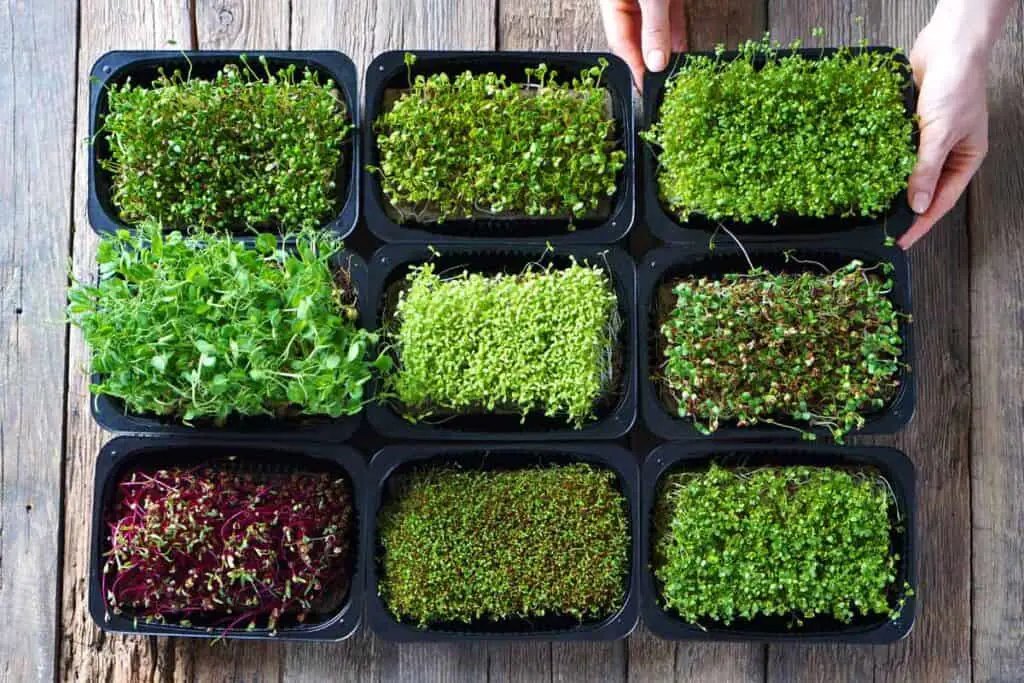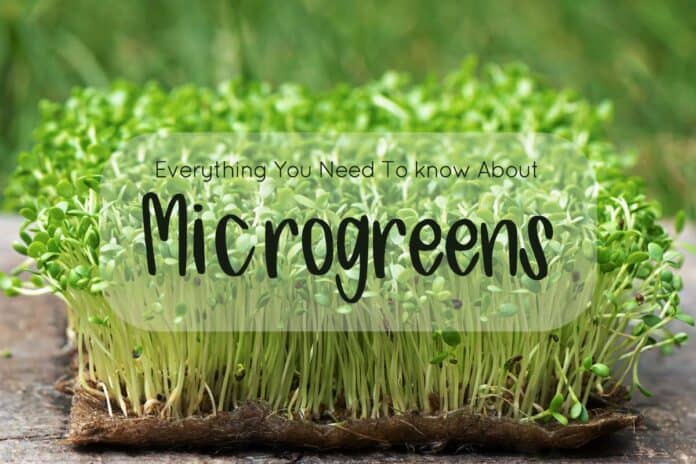While growing microgreens are increasing in popularity and more and more people are starting to cultivating them at home, many are still unaware of these amazingly healthy tiny greens.
So, what are microgreens? Microgreens are vegetables or herbs that have edible leaves and are harvested at an early stage when the plant starts to emerge. They are small in size and packed with healthy benefits. Microgreens are not a vegetable of its own, but they fall somewhere between a sprout and baby green.
Some articles will describe microgreens similar to sprouts, however, they are not the same. Sprouts are germinated seeds, they don’t have leaves and are cultivated differently.
Curious to learn more about microgreens? Continue reading, and we will explain in more detail what is all the fuss around microgreens, the benefits they bring, how easy they are grown, and how you can enjoy them in your daily diet!
What are microgreens?
They are a tiny form of young edible greens produced from vegetable, herb, or edible flowers. The term microgreen is not specific to a single type, but it’s the collective name of all these small greens that are grown and harvested just after their true leaves appears. They are typically harvested around 14 days after the seeds were planted.
Microgreens are small in size, and they reach a height of about 1-2 inches, and when they grow beyond this size and develop further leaves, they are no longer considered a microgreen.
There are more than 100 different varieties of microgreens and they are grown from different types of seeds (both vegetables and herbs).
Some of the more common microgreens to grow are:
Herbs: Anise, Basil, Borage, Chervil, Cilantro, Cress, Dill, Fennel, Parsley
Vegetables: Arugula, Broccoli, Cabbage, Kale, Kohlrabi, Lettuce, Mustard, Pea, Radish
Edible Flowers: Amaranth, Celosia, Marigold, Sunflower
You will also find a great selection of mixes, where several varieties are blended to create a combination of tastes, textures, and colors.

Microgreens are very healthy and contain a high concentration of nutrients. They are often seen in dishes at high-end restaurants where chefs have used them because of their presentation and delicate flavors. However, they are becoming increasingly popular to grow at home, which is amazing! They are often expensive to buy in the supermarket, but simple, cheap, and quick to grow on your own.
Microgreens have short shelf-lives. In general, they last around two weeks if they are stored dry in sealed containers.
RELATED: How to Store Microgreens After Harvest
Benefits of Microgreens
There are many benefits of growing and eating microgreens, and in recent years they have been noticed by people who want to grow them at home.
They are super healthy
It’s not just a buzz that microgreens are called a superfood. If you search for microgreens and health benefits, you will find an ocean of articles explaining the wealth of advantages these small greens contain. These remarks are backed up by studies done by USDA; The US Department of Agriculture. One of their studies claims that some microgreens pack more nutrients in their tiny leaves and stems than full-grown plants.
Over the past several years, chefs have touted the taste, texture, color and delicate appearance of microgreens, which include certain herb, grain and other vegetable crops. Interestingly, some microgreens pack more nutrients in their tiny leaves and stems than full-grown plants. Red cabbage microgreens, especially, have garnered attention for their potential to help protect against chronic illnesses like cardiovascular disease.
Source: USDA
They grow fast
One of the other qualities of microgreens is its ability to grow fast. From seed to harvest, it will take around two weeks. The reason for this is that microgreens are harvested before they develop into full-grown vegetables.
The duration of the growth time will vary for different kinds of seeds. The quick growth process is what makes them so favorable. You can see the results and have new greens to be harvested within a couple of weeks.
Easy to grow
Another quality is that microgreens are easy to grow, and you don’t need much experience nor expensive equipment or a garden. To grow vegetables you would normally need a garden or larger space indoors. To grow microgreens you don’t need more than the seeds, the medium, container, water, and sunlight (or artificial light)!
The Flavors of Microgreens
Microgreens have intense amounts of flavor, for many varieties, more than the full-grown vegetable. Instead of having to spread the nutrients throughout an entire mature leaf, they are concentrated in that tiny space.
Because they have such an intense flavor they are popular among chefs. They mix microgreens in with the food as well as sprinkle them on top for added texture. They look amazing as you place a small heap of them on a dish!
What types of microgreens are there?
There is an immense variety of microgreens to chose from. As microgreens are the young herbs and vegetables, there are as many options as their full-grown counterpart.
You can grow basically any vegetable and herb as microgreens, but there are some that you should not grow as microgreens (examples are tomatoes, potatoes, eggplants, and peppers). These plant sprouts are poisonous. For this reason, we suggest that you always buy seeds that are labeled for sprouts or microgreens.
If you want to start growing microgreens, these are easy to start with, they have great taste and can be used in a variety of dishes:
- Alfalfa
- Broccoli
- Cilantro
- Cress
- Kale
- Radish
If you are interested in learning more about the different types of microgreens, head to our section about microgreen types.
RELATED: Microgreen Types
The Health Benefits
Microgreens are very healthy, which makes them very popular to grow. They contain a high concentration of nutrients. Some will refer to them as a superfood, as they have a great number of health benefits. As said before, they are a mini version of the full-grown vegetable. The nutrients are concentrated within the little seedling. Depending on what variety you choose, microgreens may give you your daily dose of some essential nutrients all in one go.
What nutrients do they include?
While the exact type of nutrients varies with each type of vegetable, most microgreens have high levels of minerals, antioxidants, and vitamins.
You will also find that many varieties have great content of calcium, phosphorous, magnesium, iron, and manganese. Microgreens are a good source for nutrition, and the consumption of microgreens include essential elements beneficial to human health. Eating microgreens in addition to full-grown vegetables is a great combination as you will significantly increase your intake of nutrients.
In general, microgreens contain greater amounts of nutrients and health-promoting micronutrients than their mature counterparts. Because microgreens are rich in nutrients, smaller amounts may provide similar nutritional effects compared to larger quantities of mature vegetables.
Source: NIH
How are microgreens grown?
Microgreens are easy to grow, and it’s a quick process. You will need a few pieces of equipment to get started; seeds, the growing medium, trays, or other containers, water, and light! That’s it, you don’t need any expensive tools or a garden to grow microgreens at home.
Microgreens germinate in soil or soilless mediums such as coconut coir, and they require sunlight (or artificial light) for growth. From the day you plant your seeds to harvest time, it usually takes from 7-14 days. These small plants will grow to around two inches before they are harvested.
We have a lot resources you can read, if you want to learn more about growing microgreens.
How do you use Microgreens?
The possibilities for using microgreens are based on your own limitations. You can eat them raw, cook them, mix them in with other food, use as a garnish, stir-fry them, or even blend them in juices!
Let us give you some ideas about how you can use them.

Use as garnish
In fancier restaurants, they’re usually just used as a garnish on top of your food, and you can do the same for your meals cooked at home. Adding the microgreens as a topping is great because it makes the most simple dish look amazing. You can chop them up finely and sprinkle them over your meal or put them as they are in a pile on top. We especially like to add them to plates of pasta and our pizza.
Mix in smoothies & juices
Some microgreens are great to add in smoothies and this is a great way to increase the nutrition level! Put them in your blender together with all the other ingredients. Try Wheatgrass microgreens which are especially popular for juicing.
Stir-fry them
Microgreens are common in Asian dishes and taste awesomely stir-fried. Cut some fresh pea microgreens and fry together with garlic, ginger, soy sauce, salt, and oil.
Simple but so tasty, and it makes a delicious snack or side dish.
Mix in salads
Salads get more interesting with microgreens! Add a variety of flavors and colors into salads, and they will not only look amazing but taste great as well.
Even the most simple salad can be presented the same as in a high-class restaurant!
Put them on sandwiches and in burgers
Microgreens make a great addition to sandwiches and burgers. The small greens bring some nice texture and add a burst of flavors.
Adding a fresh mix of microgreens can replace the regular lettuce or just be a great addition. Not only will it increase your nutrition level, but it will make your next sandwich and burger shine with a hint of sweetness, spice, or bitterness!
Add them in soups
Microgreens in soups are a perfect match! When the temperature drops and you want to cuddle up with a warm soup, adding some microgreens on top will make it even better! We love to add radish microgreens on top of pumpkin soup.
RELATED: The 35 Tastiest Ways To Use Microgreens
Let us sum up!
Microgreens are great and they open a new world of gardening. Growing vegetables is no longer the luxury of those with a garden or larger indoor spaces. You can grow microgreens even if you have room for a single container placed in your window mill.
Growing your own microgreens is a satisfying experience that will make you feel successful while also saving you money at the store. Don’t be afraid to get into the world of growing microgreens. Play around with growing mediums, find what works, and find what doesn’t. At the end of the day, they’re just plants, and you can always try again.
The benefits of growing them are numerous, and we can almost guarantee that once you have started you don’t want to stop. There are so many different varieties to choose from, and as they are so quick to grow, it is fun to try out different types.
We hope that you also will find that microgreens are of great value, both for your own health, taste and for the fun of growing!


